Walter de Boynton, CFO
Walter, the construction is going to come to a grinding halt if we don't get more money.
Clement was the abbot of St. Mary's Abbey, York, and Walter de Boynton was his chief financial officer [seneschal]. Clement wanted to build the best chapter house in England. Since the chapter house was where they conducted the financial business of the abbey it was going to be Walter's conference room when it was finished. He thought the best chapter house in England would make a pretty good conference room.
St. Mary's was about 100 years old at the time. It had been founded before 1080 and it was about 1180 when Walter and Clement had this conversation. That made St. Mary's one of the first religious houses built in the north, and it had gotten off to a particularly good start. The king took it up as his own. William I permitted the establishment of the abbey in York and contributed land, and William II set it up as his foundation [Farrer, p. 265-267]. And the donations came pouring in. It was the century of founding and funding religious houses, St. Mary's had powerful sponsors, and that made it an attractive place to give land to insure the salvation of one's immortal soul.
Land was wealth, but land was not cash. And they needed cash to build the chapter house. So they cooked up a scheme for raising cash that was later emulated by most other religious houses. They rented some of their land [Wilson and Burton, p. 19]. That gave the CFO even more work to do; he had to find renters and collect the rent, in addition to managing the other abbey property. But it provided the cash needed for the construction.
Walter must have been pretty good at the business of the abbey; at least that is what one would surmise given his tenure as CFO. He worked for three abbots. Clement was the abbot from 1161 to 1184. Then Robert de Harpham became abbot and held the post until 1189. He and Walter had grown up right down the road from each other; Boynton and Harpham are small villages in the East Riding of Yorkshire only about 5 miles apart. Then Robert de Longo Campo became abbot and served until well after Walter's death. We know who the abbots were from The Chronicle of St Mary's Abbey, York [Craster and Thornton, pp. 1-2], but chief financial officers did not warrant listing in The Chronicle. Farrer, in The Early Yorkshire Charters, wrote that , "Walter de Bovington was the seneschal of the abbot of St. Mary's, York, from circa 1180 to the end of the century and perhaps later" [Farrer, p. 41]. "Bovington" is what "Boynton" was in the twelfth century. According to Farrer, Walter was preceeded as CFO by Daniel and Thomas de Wilton and succeeded by John de Octon.
They did get the chapter house finished, and it was a beauty. The chapter house was destroyed several centuries ago, of course. Henry VIII closed and sold or gave away the religious houses in England in the middle of the sixteenth century. But archaeological digging produced the stones from the entrance and other parts of the chapter house, and it has been reconstructed since. The entrance was particularly impressive. This is an artist's imagining what it would have looked like in its glory.
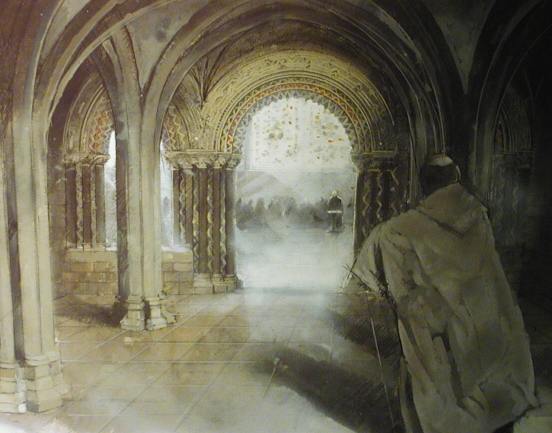 |
The contemporary version of the entrance that has been reconstructed is a bit less impressive than the artist's rendition. They have a reflecting object in front of the central entrance and you can see the reflection of the photographer in the picture.
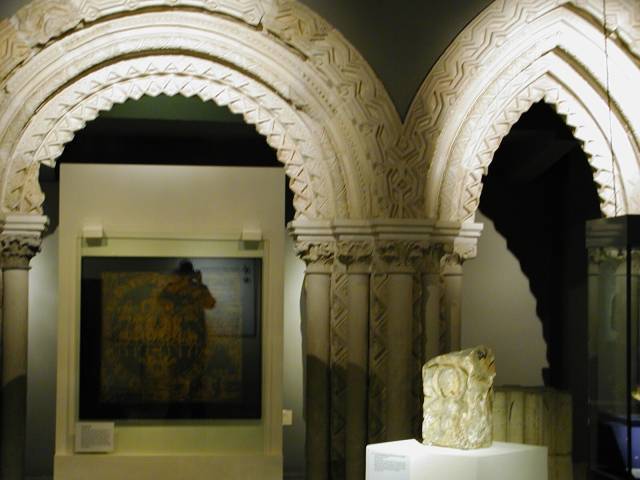 |
In addition to finding many pieces of the entrance several of the statues were found. The one on the left is Moses. The one in the middle is an observer. And the one on the right is an unidentified apostle.
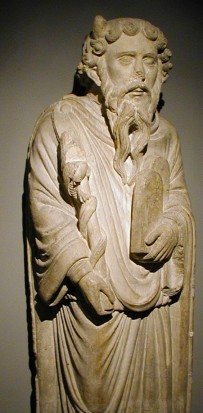 |
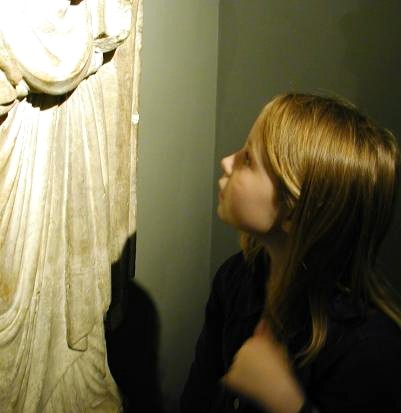 |
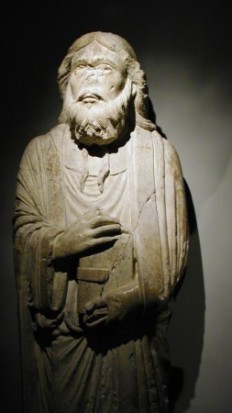 |
Moses and the saint are larger than life. They are large enough to impress our eight year old observer and us all.
The chapter house was built. What of the business of the abbey? We know it was a wealthy land holder, the richest religious house in the north when it was closed by Henry VIII, but that was 350 years after Walter. A lot can change in three and one-half centuries. Religious houses compiled a formal record of their transactions and the charters recording the transactions because there was no county registrar of deeds who maintained an official record. Many of the chartularies have been published, but there is no printed chartulary for St. Mary's Abbey, York. However, several manuscript sources of charters for St. Mary's were incorporated into The Early Yorkshire Charters. So we can count charters in that twelve volume set as a rough indication of the scope of economic activities. There are about 250 charters involving St. Mary's Abbey recording gifts, exchanges, and leases. Many of the charters record transactions that happened while Walter was CFO. Charters was not all Walter did as CFO, but it is all that we have records for.
Walter worked at St. Mary's Abbey for more than two decades. He was there when they built what has been acclaimed as a magnificent chapter house. And he was there during an important period of building the financial base of the abbey. There were already hundreds of plots of land to be managed. That was the business of the abbey, and the abbey's business was his business -- he was the chief financial officer.
....
Craster, H.H.E. and M. E. Thornton (1934) The Chronicle of St Mary's Abbey, York from Bodley MS. 39, Surtees Society series vol. 148.
Farrer, William (1914) Early Yorkshire Charters, vol. 1.
Wilson, Christopher and Janet Burton (1988) St. Mary's Abbey, York